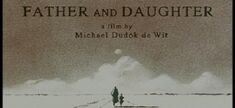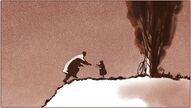Then the daughter comes to the shore every year. Waiting for my father to return. Changes in weather and passers-by constitute the intertextual and polyphonic structure of the film.
I would also like to mention the Japanese translation: "Two People on the Shore". It's wise to highlight the shore (the line between life and death). However, the original name is simpler.
For small children, death is the mysterious sea that looks out from afar, taking away our loved ones.
People grow old slowly, and the sea that hides above death gradually recedes and becomes a tidal flat. It turns out that this tidal flat also has complex terrain and water birds, and death has changed from a dull and cruel sea to a more meaningful area. It should be noted here that when the sea becomes a tidal flat, it is when the girl becomes an old woman. The reason is that she had lost her husband and children by then.
When she came to shore for the last time, the worn bike fell over several times. She picked up, fell, picked up, fell again. Finally, she gave up, looked back, and stopped helping. The lying bicycle is left behind, a symbol of no return. She walked down the embankment. At this time, the embankment has changed from swamp to grass.
"Through neck-length grass before reaching the heart of death."
This is my favorite imagery. The road from dying to death is long. Along the way, the tall grass was rustled by life like a candle.
Finally, the old woman found the boat that "taken my father away" and "half-buried in the sand", and tentatively felt the side of the boat, stepped on the sand, and finally lay down satisfied. At this time, death and her father became one, and she was lying in the arms of death and in the arms of her father. It's easy to understand after that.
View more about Father and Daughter reviews







